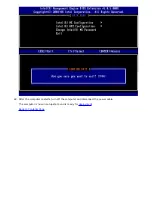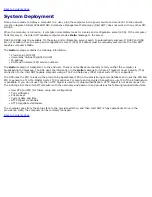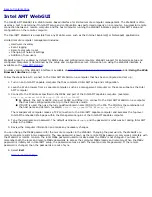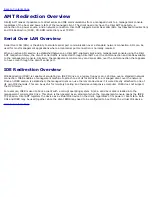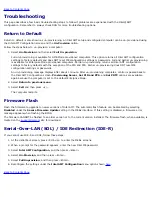
Back to Contents Page
System Deployment
Once you are ready to deploy a computer to a user, plug the computer into a power source and connect it to the network.
Use the integrated Intel® 82566DM NIC. Intel Active Management Technology (Intel AMT) does not work with any other NIC
solution.
When the computer is turned on, it computer immediately looks for a setup and configuration server (SCS). If the computer
finds this server, the Intel AMT capable computer sends a
Hello
message to the server.
DHCP and DNS must be available for the setup and configuration server search to automatically succeed. If DHCP and DNS
are not available, then the setup and configuration servers (SCS) IP address must be manually entered into the Intel AMT
capable computer's MEBx.
The
Hello
message contains the following information:
Provisioning ID (PID)
Universally Unique Identifier (UUID)
IP address
ROM and firmware (FW) version numbers
The
Hello
message is transparent to the end user. There is no feedback mechanism to tell you that the computer is
broadcasting the message. The SCS uses the information in the
Hello
message to initiate a Transport Layer Security (TLS)
connection to the Intel AMT capable computer using a TLS Pre-Shared key (PSK) cipher suite if TLS is supported.
The SCS uses the PID to look up the provisioning passphrase (PPS) in the provisioning server database and uses the PPS and
PID to generate a TLS Pre-Master Secret. TLS is optional. For secure and encrypted transactions, use TLS if the infrastructure
is available. If you do not use TLS, then HTTP Digest is used for mutual authentication. HTTP Digest is not as secure as TLS.
The SCS logs into the Intel AMT computer with the username and password and provisions the following required data items:
New PPS and PID (for future setup and configuration)
TLS certificates
Private keys
Current date and time
HTTP Digest credentials
HTTP Negotiate credentials
The computer goes from the setup state to the provisioned state, and then Intel AMT is fully operational. Once in the
provisioned state, the computer can be remotely managed.
Back to Contents Page
Summary of Contents for Active Management Technology v5.0
Page 32: ...4 Click the to expand the Intel AMT Getting Started section ...
Page 33: ...5 Click the to expand the Section 1 Provisioning section ...
Page 34: ...6 Click the to expand the Basic Provisioning without TLS section ...
Page 37: ...The IP address for the ProvisionServer and Intel SCS are now visible ...
Page 38: ...9 Select Step 2 Discovery Capabilities ...
Page 40: ...11 Select Step 3 View Intel AMT Capable Computers ...
Page 41: ...Any Intel AMT capable computers on the network are visible in this list ...
Page 42: ...12 Select Step 4 Create Profile ...
Page 43: ...13 Click the plus symbol to add a new profile ...
Page 47: ...15 Select the icon with the arrow pointing out to Export Security Keys to USB Key ...
Page 48: ...16 Select the Generate keys before export radio button ...
Page 55: ...27 Select Step 7 Monitor Provisioning Process ...
Page 57: ...28 Select Step 8 Monitor Profile Assignments ...
Page 60: ...Back to Contents Page ...
Page 66: ...9 Select Intel ME Features Control and then press Enter ...
Page 68: ...10 Select Return to Previous Menu and then press Enter ...
Page 69: ...11 Select Intel ME Power Control and then press Enter ...
Page 70: ...Intel ME ON in Host Sleep States is the next option The default setting is Mobile ON in S0 ...
Page 71: ...12 Select Return to Previous Menu and then press Enter ...
Page 72: ...13 Select Return to Previous Menu and then press Enter ...
Page 76: ...8 Type the domain name into the Domain name field ...
Page 78: ...11 Select Setup and Configuration from the menu and then press Enter ...
Page 81: ...14 Select Provisioning Server from the menu and then press Enter ...
Page 84: ...17 Select Provisioning Server FQDN from the menu and then press Enter ...
Page 85: ...18 Type the fully qualified domain name FQDN for the provisioning server and press Enter ...
Page 86: ...19 Select TLS PSK from the menu and then press Enter ...
Page 89: ...22 Select TLS PKI from the menu and then press Enter ...
Page 93: ...26 Select Return to Previous Menu and press Enter ...
Page 96: ...28 Select SOL IDE R and then press Enter ...
Page 99: ...For Serial Over LAN SOL IDE R select Enabled and then press Enter ...
Page 100: ...For IDE Redirection select Enabled and then press Enter ...
Page 101: ...Password Policy is the next option The default setting is Default Password Only ...
Page 102: ...Secure Firmware Update is the next option The default setting is Enabled ...
Page 103: ...Skip Set PRTC ...
Page 105: ...30 Select Return to Previous Menu and then press Enter ...
Page 106: ...31 Select Exit and then press Enter ...
Page 107: ...32 Press y when the following message appears Are you sure you want to exit Y N ...
Page 114: ...10 Select Intel ME Features Control and then press Enter ...
Page 116: ...11 Select Return to Previous Menu and then press Enter ...
Page 117: ...12 Select Intel ME Power Control and then press Enter ...
Page 118: ...Intel ME ON in Host Sleep States is the next option The default setting is Mobile ON in S0 ...
Page 119: ...13 Select Return to Previous Menu and then press Enter ...
Page 120: ...14 Select Return to Previous Menu and then press Enter ...
Page 124: ...8 Type the domain name into the field ...
Page 129: ...15 For Serial Over LAN select Enabled and then press Enter ...
Page 130: ...16 For IDE Redirection select Enabled and then press Enter ...
Page 131: ...17 For Password Policy select Enabled and then press Enter ...
Page 132: ...Secure Firmware Update is the next option The default setting is Enabled ...
Page 133: ...18 Skip Set PRTC ...
Page 135: ...19 Select Return to Previous Menu and then press Enter ...
Page 136: ...20 Select Exit and then press Enter ...
Page 137: ...21 Press y when the following message appears Are you sure you want to exit Y N ...














